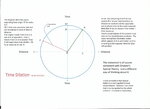Hartmann 352 in a previous thread said, if I remember correctly, that anti matter particles can be regarded as 'ordinary' +ve particles but heading opposite in time.
I believe he also said that both anti particles and +ve particles move through time in a positive way. That is they both move to the future and not back to the past.
At first sight this seems contradictory, However there is a scenario where this is logically resolved and, also, resolves the issue "where is the antimatter" without threatening universe annihilation . This would concern a hypershere and an assumption that time for a particle is a movement physically through a 4th Spatial dimension. The movement in an opposite direction of one partcle to another (in an additional direction to the 3 constituting 3d space) as is possible in a hypersphere, designates opposite charges. Which is positive and which is negative would depend on the location of an observer.
So at one location in a hypersphere (perhaps our universe) where an observer exists - all particles in that hemisphere can be observed positive and also all particles in the opposite hemishere may then be regarded as negative. Simply put, in an hyperspherical universe all the anti matter is on the opposite side to us. This situation would exist for anyone located anywhere; particles would always locally to be positive (mostly).
The solution would be the nature of Time itself. Time would have to be movement in a fourth spatial dimension. That is not only is the 3d space in the universe expanding but there is 4d space which is expanding (where we, are like 2d flatlanders who cannot move a 2d plain) in an additional spatial dimension. A different interpretation to spacetime I think.
Look - a better idea of what time is... Lets say we draw a little man on a piece of paper. There is no obvious method by which the man can move about! But we can introduce time as a whole pile of pieces of paper. On each adjacent piece we can draw the man in a slightly different place. If we flick through the papers it seems as if the man is moving. So, time for the man is the depth of the pile - a direction at right angles to each of his pieces of paper. A dimension he might call time; a spatial dimension.
Oops moving off the subject, lol. What do you think?
I believe he also said that both anti particles and +ve particles move through time in a positive way. That is they both move to the future and not back to the past.
At first sight this seems contradictory, However there is a scenario where this is logically resolved and, also, resolves the issue "where is the antimatter" without threatening universe annihilation . This would concern a hypershere and an assumption that time for a particle is a movement physically through a 4th Spatial dimension. The movement in an opposite direction of one partcle to another (in an additional direction to the 3 constituting 3d space) as is possible in a hypersphere, designates opposite charges. Which is positive and which is negative would depend on the location of an observer.
So at one location in a hypersphere (perhaps our universe) where an observer exists - all particles in that hemisphere can be observed positive and also all particles in the opposite hemishere may then be regarded as negative. Simply put, in an hyperspherical universe all the anti matter is on the opposite side to us. This situation would exist for anyone located anywhere; particles would always locally to be positive (mostly).
The solution would be the nature of Time itself. Time would have to be movement in a fourth spatial dimension. That is not only is the 3d space in the universe expanding but there is 4d space which is expanding (where we, are like 2d flatlanders who cannot move a 2d plain) in an additional spatial dimension. A different interpretation to spacetime I think.
Look - a better idea of what time is... Lets say we draw a little man on a piece of paper. There is no obvious method by which the man can move about! But we can introduce time as a whole pile of pieces of paper. On each adjacent piece we can draw the man in a slightly different place. If we flick through the papers it seems as if the man is moving. So, time for the man is the depth of the pile - a direction at right angles to each of his pieces of paper. A dimension he might call time; a spatial dimension.
Oops moving off the subject, lol. What do you think?



